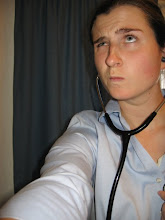I will spent my last month in Africa taking a course offered through the Tulane University School of Public Health and Tropical Medicine. The course is INHL 653 and it is called, "Health and Development in Kenya in the Time of HIV/AIDS." It is a 3 credit class and will satisfy my credit requirements for graduation.
The class had 10 students, 2 professors and a TA. One of the professors has connections with Samburu District and the other primary professor works in the Western and Nyanza Districts.
 This is our primary professor, Dr. Murphy, with her son Callum. She is an amazing teacher and was able to bring discussion and learning into every experience.
This is our primary professor, Dr. Murphy, with her son Callum. She is an amazing teacher and was able to bring discussion and learning into every experience.Our Itinerary was:
1) Spent 2 days in Nairobi. We visited the Nation AIDS Control Program, TICHA (an organization working with indigenous medicine and traditional healers), Movement of Men Against AIDS, and the AMREF head office. We had an interesting writing assignment on the difference between the 'mainstream' and 'alternative/traditional' ways to manage HIV/AIDS.
2) Traveled to the foothills of Mount Kenya and went for a nature hike.
3) Traveled to Samburu District. There we were hosted by the SAIDIA (saidia means 'help' in Swahili) Clinic and got to see a variety of activities. We took a tour of the clinic, then went out with mobile clinic team. On the mobile clinic site all of us students got to assist with growth monitoring (weighing babies), giving immunizations and sit in on maternity check ups in the very rural areas of Samburu. Then we went to visit a local school, went on a hike to see a bee project, and met with traditional birth attendants. On the last day of our visit in the Samburu district we got the opportunity to 'give back to the clinic.' Two other students and I were on a team that dug a huge pit for the clinic to burn their medical waste (needles, etc.) in. Not exactly how we take care of medical waste in the United States. We had a writing assignment analyzing how to improve services at the Samburu SAIDIA clinic.
4) Next we spent a day of relaxation at a lake.
5) From the lake we drove 8 hours to Kakichuma Village in Bungoma. This is a village where one of our professors has been studying how households use kitchen gardens and indigenous greens to respond/mitigate the impacts of HIV. We stayed in Kakichuma for a week and it was getting a little old by the end of the visit especially since it rained everyday and my tent leaked. Not so much fun. I don't really enjoy camping in th rain. Here we had an assignment to make a PowerPoint presentation to teach Tulane undergraduates about the HIV situation in Kakichuma village.
6) From Kakichuma we drove down the Kisumu and then crossed a section of Lake Victoria on a ferry. It wasn't exactly the same standard of ferries we have in Washington State, but it was safe (I guess). We stayed int the Village of Nyapuodi for 4 nights. Our professor also does research in this village about how labor-saving farming techniques are or are not being utilized to help families impacted by AIDS. This is a small village about 17 kilometers from Lake Victoria. Unfortunately, this is the area of Kenya most severely impacted by HIV/AIDS. The village has only 150 people. One of the most touching things in the class was when a bunch of village elders all gathered around a map of the village and wrote down where all the deaths from HIV had occurred during the last two years. In Nyapuodi we saw some work by Heifer International giving dairy goats to people living with HIV, as well as seeing an expensive plough that no one in the village could afford. We also went to see a fish village on the edge of Lake Victoria and learned about how women who sell fish for a living have to have sexual relationships with the fishermen to get fish to sell. This has contributed to the explosive spread of HIV in the area. At this sight we wrote about the relationship between HIV/AIDS and development and had some very interesting discussions.

7) Next we went to the Mara National Park and spent a day going for a game drive. We got to see lions which was quite exciting. At first I didn't see how the game drive would factor into a class about health and development in Kenya. However, our professor incorporated very interesting readings and discussion about 'wildlife tourism' and the impact it has on the lives and health of Kenyans in the area.

8) We returned to Nairobi and had one last day of discussions, before departing for our separate ways.
It was a great class.




No comments:
Post a Comment